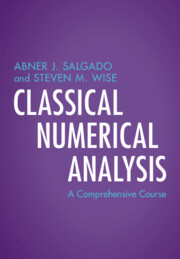Book contents
- Frontmatter
- Contents
- Preface
- Acknowledgements
- Symbols
- Part I Numerical Linear Algebra
- Part II Constructive Approximation Theory
- Part III Nonlinear Equations and Optimization
- Part IV Initial Value Problems for Ordinary Differential Equations
- Part V Boundary and Initial Boundary Value Problems
- 23 Boundary and Initial Boundary Value Problems for Partial Differential Equations
- 24 Finite Difference Methods for Elliptic Problems
- 25 Finite Element Methods for Elliptic Problems
- 26 Spectral and Pseudo-Spectral Methods for Periodic Elliptic Equations
- 27 Collocation Methods for Elliptic Equations
- 28 Finite Difference Methods for Parabolic Problems
- 29 Finite Difference Methods for Hyperbolic Problems
- Appendix A Linear Algebra Review
- Appendix B Basic Analysis Review
- Appendix C Banach Fixed Point Theorem
- Appendix D A (Petting) Zoo of Function Spaces
- References
- Index
24 - Finite Difference Methods for Elliptic Problems
from Part V - Boundary and Initial Boundary Value Problems
Published online by Cambridge University Press: 29 September 2022
- Frontmatter
- Contents
- Preface
- Acknowledgements
- Symbols
- Part I Numerical Linear Algebra
- Part II Constructive Approximation Theory
- Part III Nonlinear Equations and Optimization
- Part IV Initial Value Problems for Ordinary Differential Equations
- Part V Boundary and Initial Boundary Value Problems
- 23 Boundary and Initial Boundary Value Problems for Partial Differential Equations
- 24 Finite Difference Methods for Elliptic Problems
- 25 Finite Element Methods for Elliptic Problems
- 26 Spectral and Pseudo-Spectral Methods for Periodic Elliptic Equations
- 27 Collocation Methods for Elliptic Equations
- 28 Finite Difference Methods for Parabolic Problems
- 29 Finite Difference Methods for Hyperbolic Problems
- Appendix A Linear Algebra Review
- Appendix B Basic Analysis Review
- Appendix C Banach Fixed Point Theorem
- Appendix D A (Petting) Zoo of Function Spaces
- References
- Index
Summary
This chapter studies finite difference methods for elliptic problems. It begins with a rather lengthy and general discussion of grid domains, grid functions, finite difference operators, and their consistency. We then introduce the notion of stability of a finite difference scheme and Lax’s principle: a consistent and stable scheme is convergent. Then we apply all these notions to elliptic operators in one and two dimensions, with the main focus being the Laplacian. We show the discrete maximum principle, energy arguments and how these can be used to attain stability and convergence in various norms. For more general operators we introduce the notions of homogeneous schemes and upwinding. For operators in divergence form we provide an analysis via energy arguments. For non divergence form operators we analyze the monotonicity and comparison principles of the arising schemes.
Keywords
Information
- Type
- Chapter
- Information
- Classical Numerical AnalysisA Comprehensive Course, pp. 664 - 699Publisher: Cambridge University PressPrint publication year: 2022
